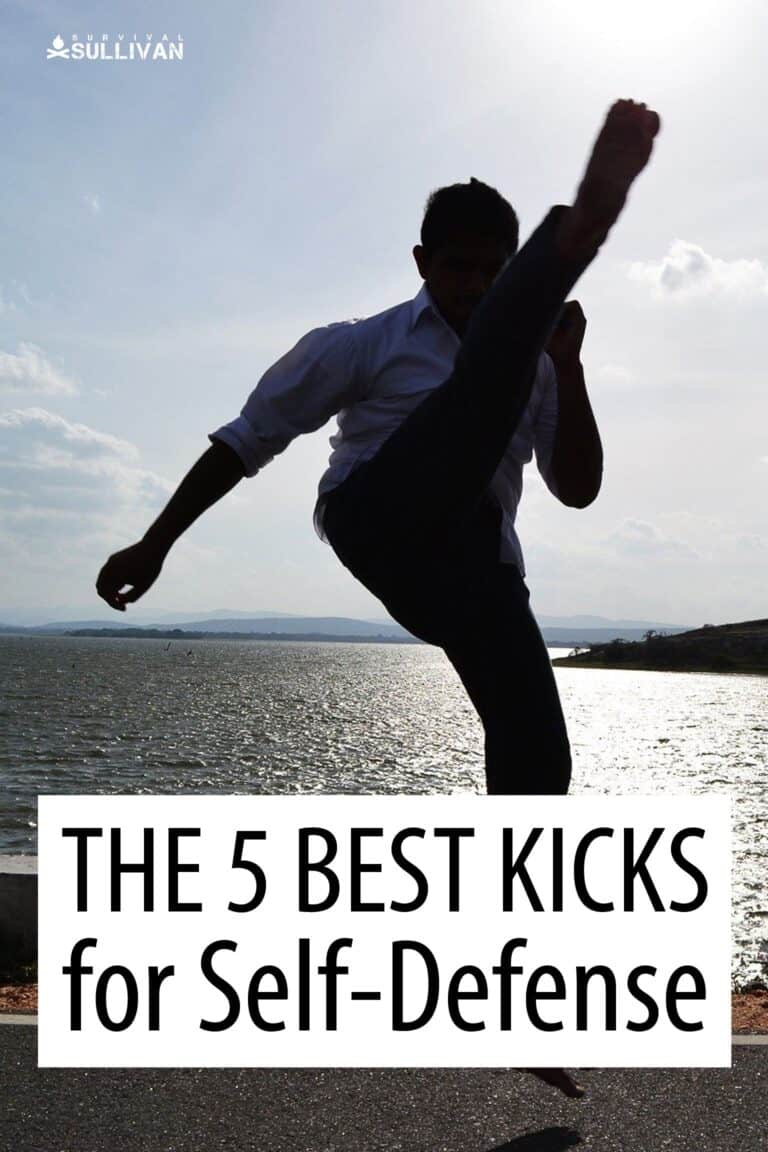Kicking and punching are natural instincts when it comes to fighting. Over the eight years that I’ve been training in taekwondo, I’ve had many, many sparring matches and seen and used many different kicks.

Now, not all kicks are equal and self-defense is very different from a sparring match in a Dojo. With that in mind, I thought I’d look at a few different kicks and see which ones are the best to use in self-defense situations.
Why Kick in a Fight?
While both kicking and punching are both effective, kicking allows you to be slightly further away from your opponent as your legs are longer than your arms. It also helps to create distance between the two of you if you need a breather or, in a self-defense situation, space to run.
Additionally, you have more muscle in your legs which allows for a much more powerful strike and greater damage.
5 Basic Kicks for Self-Defense Situations
Taekwondo has an array of kicks to choose from as the sport is heavily reliant on kicks. This can make determining the best kicks a bit tricky but it’s not impossible. I won’t go into detail on every kick in the taekwondo catalog but I will discuss a handful of them.
1. Front Kick
Often the very first kick you learn in martial arts; the front kick is by far the easiest and most versatile kick in your arsenal. It’s a good medium range kick that can be used to fend off an attacker fairly well. It can also be a rather…shall we say ‘unpleasant’ experience for the guy on the business end depending on the target.
As far as planning goes, that’s the best part; there isn’t really a single way to set up a front kick. All you really need to do is swing your leg forward; as long as your foot hits something it’s technically a front kick. It can look absolutely god-awful but if it works then that’s all that matters.
Pros:
- ✅ User-friendly, easy to setup and pull off
- ✅ Strong, stable attack
- ✅ Easy to follow up with punches and/or kicks
- ✅ Flexible technique, easily adapted
Cons:
- ❌ Easy to catch
- ❌ Presents several fantastic targets to be hit/kicked
2. Side Kick
A side kick is a very powerful kick and it’s also a fairly simple kick to set up. You’re standing sideways, your front knee (the knee of your kicking leg) comes up to your opposite shoulder and you kick your leg out sideways – hence the name.
As simple as it is, this one will require a bit of practice because you’re in a bit of an awkward position for fighting.
That said, this one is devastating when it lands with any kind of speed and/or power behind it. You can use it to create a fair amount of distance and buy yourself some time to think and/or run.
Pros:
- ✅ Powerful
- ✅ Good range
- ✅ Fairly easy to pull off – with a bit of practice
Cons:
- ❌ Your balance is a little off
- ❌ Difficult to follow up with other techniques due to your body position
- ❌ Missing a kick leaves you very vulnerable
- ❌ Not as flexible as a front kick
3. Knee Strike
Yes, a knee strike is technically a kick and it’s a nasty one to get. It’s a powerful strike, driving the hard point of your knee up and your hips forward to deliver a blow – usually to the solar plexus or diaphragm – and knock the wind out of the other guy.
Like the front kick, the knee strike is incredibly simple and easy to use; it’s kind of difficult to miss considering how close you are. There is a serious drawback to this one, however, it has limited range. A knee strike is a close-range attack, so you have to be very close to your opponent/attacker.
One other drawback is the awkward position that your body ends up in for a second – standing on one leg isn’t exactly ideal when you’re in a fight – but it’s not difficult to avoid this problem.
Pros:
- ✅ Powerful, painful strike
- ✅ Easy to use
- ✅ Easy to follow up with other punches and kicks
Cons:
- ❌ Limited range
- ❌ Throws your balance off for a second
04. Back Kick
You know how you’re always told not to walk behind a horse? They kick, right?
Well, that’s kind of the point of this one. It’s a sneak attack that nobody will really expect it. It’s easy enough to pull off, pick your leg up and thrust backward, driving the heel of your foot into your attacker.
With that said, it’s also a bit awkward as far as fighting goes as it’s difficult to follow up on a back kick with other techniques. Why? Well, you are standing with your back to your attacker.
Pros:
- ✅ Powerful
- ✅ Easy enough to use
Cons:
- ❌ A bit awkward
- ❌ Difficult to follow up with other techniques
5. Roundhouse Kick
Ah, the roundhouse kick. Probably one of the most well-known kicks in martial arts, this one is very powerful.
Put one of these in the side of an attacker and it may persuade them to pick on someone else. This one requires a bit of practice because it throws your balance off quite a bit (trust me, I know).
The power of this kick comes from the rotation of the hips and the snapping motion of the lower leg. While it’s easy to follow up with other techniques, there are a few drawbacks to this one, it throws your balance off and is very easy to catch if you miss your target which makes it a risky kick to try.
Pros:
- ✅ Powerful
- ✅ Fast
- ✅ Easy to follow up
- ✅ Can do a lot of damage
Cons:
- ❌ Compromises your balance
- ❌ Easy to catch
- ❌ Missing a kick leaves you vulnerable
Final Thoughts
There you have it, five of the best kicks to use in self-defense. Of course, a better idea would be to not get into self-defense situations at all, but that’s not always an option, is it? Still, it’s good to know what you can and can’t do in these types of situations.
With that said, I hope you guys enjoyed the article and found it informative. As always, thanks for reading. I’ll see you for the next one, take care!


Greg spent much of his younger years camping and hiking. Greg grew up on a small farm with lots of livestock such as cows, horses and chickens. He’s good with a bow and arrow, is a huge knife enthusiast, and has a blackbelt in Taekwondo.
